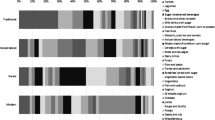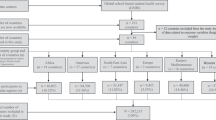Abstract
Objective: To analyse the association between nutritional and familial factors and obesity in boys and girls.
Design: Randomized, cross-sectional population study.
Setting: Province de Luxembourg, Belgium.
Subjects: One thousand and twenty-eight boys and girls in age strata 6–8, 8–10 and 10–12 y, comprising 70.3% of primary cohort.
Methods: Examinations included anthropometric measurements and questionnaires covering familial, socioeconomic and psychosocial factors. A three day dietary record was obtained in 955 children. This was analysed in relation to the anthropometric data.
Results: In comparison with similar studies from other regions and recommended allowances, the intakes of total energy, fat, particularly saturated fat and cholesterol, were high, while consumption of carbohydrate and fiber was low, as well as the polyunsaturated/saturated ratio of fat. Total energy intake showed no or weakly significant correlations with anthropometric factors. However, total fat (P=0.045) and saturated fat (P=0.0005) intake showed consistent positive correlations with body mass index (BMI, kg/m2) and skinfold thickness, with corresponding negative relationships to carbohydrate intake (P=0.034) in boys. Such relationships were also found when calculated as energy density. These associations were not statistically significant in girls. The high fat, low carbohydrate pattern of the nutritional status seemed to be more pronounced in families where the father had a low level of education (lipids, boys, P=0.0007), and where both parents were obese (saturated fat, boys, P=0.023), suggesting involvement of socioeconomic and familial factors.
Conclusion: The lack of correlation between factors indicating obesity and total energy intake suggests that the positive energy balance causing obesity is due mainly to a low energy output. However, since energy intake measurements are imprecise, overeating can not be excluded, particularly since elevated consumption of food with high contents of fat, found in these children seems to be poorly regulated.
This is a preview of subscription content, access via your institution
Access options
Subscribe to this journal
Receive 12 print issues and online access
$259.00 per year
only $21.58 per issue
Buy this article
- Purchase on Springer Link
- Instant access to full article PDF
Prices may be subject to local taxes which are calculated during checkout
Similar content being viewed by others
Author information
Authors and Affiliations
Rights and permissions
About this article
Cite this article
Guillaume, M., Lapidus, L. & Lambert, A. Obesity and nutrition in children. The Belgian Luxembourg Child Study IV. Eur J Clin Nutr 52, 323–328 (1998). https://doi.org/10.1038/sj.ejcn.1600532
Received:
Revised:
Accepted:
Published:
Issue Date:
DOI: https://doi.org/10.1038/sj.ejcn.1600532
Keywords
This article is cited by
-
Relationship between 8/9-yr-old school children BMI, parents' BMI and educational level: a cross sectional survey
Nutrition Journal (2011)
-
Television viewing and obesity: a prospective study in the 1958 British birth cohort
European Journal of Clinical Nutrition (2008)
-
General and visceral adiposity in black and white adolescents and their relation with reported physical activity and diet
International Journal of Obesity (2007)
-
Watching television is associated with childhood obesity: but is it clinically important?
International Journal of Obesity (2006)
-
Evidence in Female Rhesus Monkeys (Macaca mulatta) that Nighttime Caloric Intake is not Associated with Weight Gain
Obesity Research (2005)



